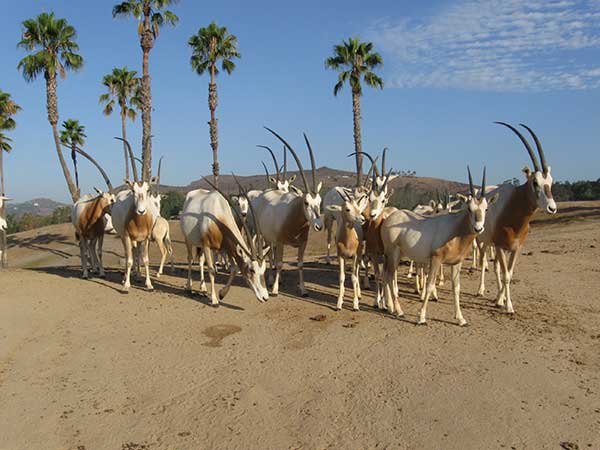
Since San Diego Zoo Wildlife Alliance is a proud member of the Association of Zoos & Aquariums (AZA), we share best practices and individual animals with other nationwide AZA institutions to ensure the genetic health of the species we work so hard to conserve and display. As such, there are times when juvenile and adult animals will be selected to be moved to another zoo to help their breeding program, or to help ours.
This story focuses on one such animal, a young scimitar horned oryx male who was being pulled from the field, given a health exam and being staged for a pending move to his new home. Since these field herds live their lives virtually untouched, they behave very much as their wild counterparts would and are generally not tame or trained. Although we do our best to make their transition from the field to their new home as easy as possible, it is still a stressful experience to be removed from the herd, loaded on a trailer and moved to somewhere new.
Our young oryx’s journey started well and his exam went smoothly. All was ready to receive him in his new temporary holding before his big trip to his new permanent home. It had been a big day for him and we were at the last step of the process, offloading him from the trailer. All he had to do was step off the back step and walk into his new yard with its fresh food and well deserved rest. But he would not budge.
This boy refused to leave the trailer. This isn’t entirely uncommon, as sometimes an animal will perceive the pending unknown beyond the trailer as more of a threat than the trailer itself, resulting in a refusal to leave. Having seen this scenario before, we did all the things we knew to encourage him to leave the trailer, starting with giving him time to consider his options. Sometimes, a little extra time is all that is needed. Regrettably, this guy was set on staying put and was getting increasingly agitated with each attempt to encourage his movement.
My position on the team was down a long outdoor chute, manning the very last door to the yard after a series of chute doors that discouraged an animal from changing direction and traveling back to the trailer. I was out of sight of the trailer and my fellow staff. I could hear that they were having difficulty, but I couldn’t see them and they couldn’t see me. I decided to try and get internally quiet and connect with this boy to understand his hesitation. I wanted to mentally show him the nice open space that awaited him, easing any concern for what lies beyond the trailer door. What I got from him, quite frankly, surprised me.
I experienced the sensation of being physically disoriented. My vision seemed altered and the ground came up to meet my feet faster than expected. My sense of balance was totally off kilter and I felt unable to keep the trailer room from spinning. I could not navigate the level floor, much less the huge step off the back of the trailer. I immediately thought, “My gosh! The drugs from his exam haven’t worn off yet. He’s still affected by the anesthesia and isn’t fully in his body.”
Fortunately, it was technically past our lunch time. It was easy bait to suggest to the crew that we close the trailer and park him in the shade while we go to lunch, giving him another 45 minutes to finish recovering from the anesthetics in his system. I believed strongly that he would be calmer and compliant leaving the trailer once he felt in control of his “legs” again. Outwardly, he looked like he was fully awake, but my reading of him told me otherwise.
When we returned to give him another try, he peacefully stepped down out of the trailer and trotted down to his new yard and began to eat. The contrast from the first session to the second was totally stunning. Everyone chalked it up to the often frustrating realities of trailering wild hoofstock. Thanks to my connection and experience of not yet having my “sea legs”, I knew the real cause of the trouble.
There is always a reason for behavior. When we understand the reason, we can make kinder and more effective choices in our animal partnerships. In this case, both he and I were relieved to be standing on solid ground.
